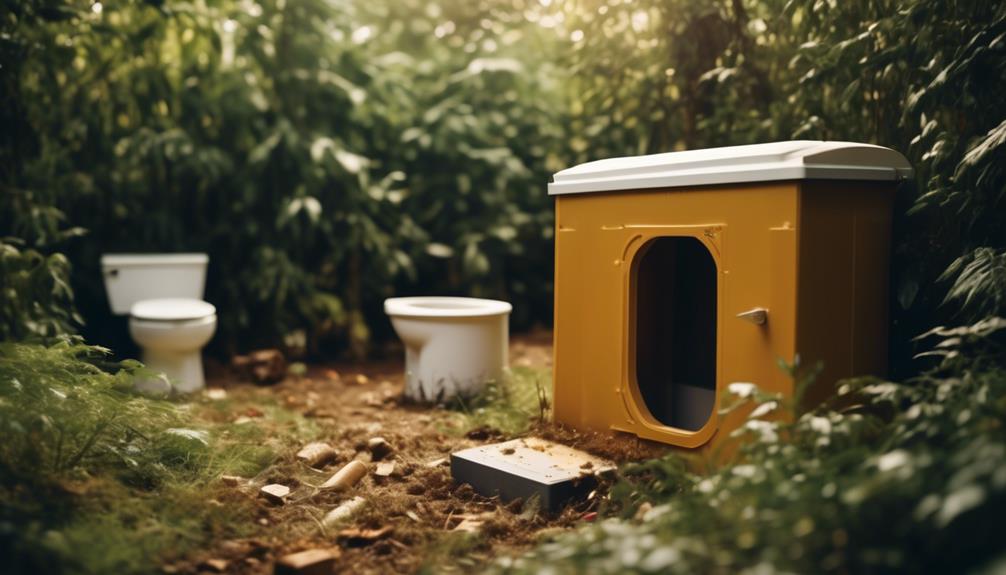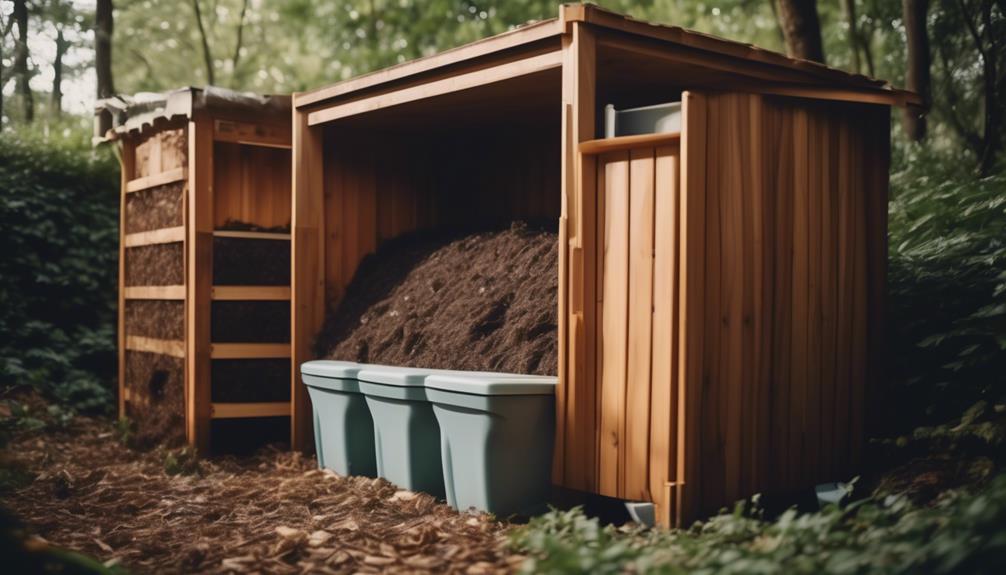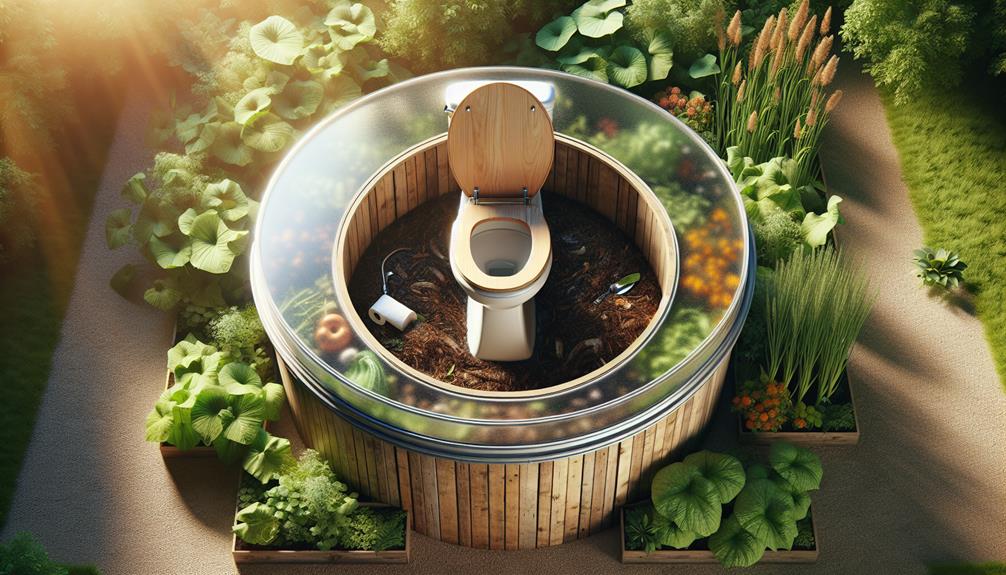Are you tired of dealing with waste in a less-than-ideal manner?
Well, we have a solution that will completely transform your waste management practices.
This DIY composting toilet is not only environmentally friendly but also allows you to turn your waste into valuable compost.
Imagine the possibilities of having a sustainable and eco-friendly solution right in your own home.
Intrigued? Keep reading to find out how you can revolutionize waste management and make a positive impact on the environment.
Key Takeaways
- A DIY composting toilet can be built using materials such as a 5-gallon bucket, plastic urine diverter, straw or sawdust, compost pile, and garden hose.
- The plumbing hardware can be attached to the toilet by cutting a hole in the bucket, attaching the hardware inside, and connecting the urine diverter using cotter pins and rubber washers.
- A garden hose can be added to the composting toilet to provide a path for waste to flow into a urine holding container.
- When using the composting toilet, it is important to keep urine out of the compost, sit entirely on the seat when peeing, use substrate cover material to conceal waste, and empty the waste bucket into a compost drum for further composting.
Materials and Tools Needed
To begin building your DIY composting toilet, gather the necessary materials and tools. Creating your own composting toilet not only benefits the environment but also provides a sustainable solution for waste management.
By repurposing a 5-gallon bucket, you can easily construct a composting toilet that's both innovative and practical. You'll need a plastic urine diverter, straw or sawdust for cover material, a compost pile for waste disposal, and a garden hose for plumbing.
Installation tips include cutting a hole in the side of the bucket, attaching the plumbing hardware pieces inside, and sealing any gaps with caulk.
With these materials and steps, you can create a DIY composting toilet that's eco-conscious and efficient in managing waste.
Building the DIY Composting Toilet
Start building your DIY composting toilet by repurposing a 5-gallon bucket and incorporating eco-conscious plumbing hardware. This innovative approach offers several benefits and challenges.
Benefits of using a composting toilet with a urine diverter include reducing water usage, minimizing odor, and producing nutrient-rich compost.
Challenges may include proper maintenance, ensuring proper ventilation, and managing the composting process effectively.
When comparing DIY composting toilets to commercially available options, the DIY approach allows for customization, cost savings, and a sense of self-sufficiency.
However, commercially available options may offer more advanced features, such as automatic stirring mechanisms and odor control systems.
Using the Composting Toilet With Urine Diverter

You can effectively utilize the composting toilet with a urine diverter by following these eco-conscious and practical steps.
To properly clean a composting toilet with a urine diverter, use vinegar to clean the toilet and avoid pouring water into it. This will help maintain a healthy composting process and prevent odors.
When using the toilet, make sure to sit entirely on the seat when peeing to allow the urine diverter to work effectively. Use substrate cover material when going number two and add enough cover material to conceal the waste.
Troubleshooting common issues with composting toilets can include checking the seals and replacing them if necessary, as well as ensuring that the compost drum is properly covered and cured for a year before using the compost as fertilizer.
Emptying and Maintaining the Compost
As you continue your sustainable journey with the composting toilet, an important aspect to consider is the proper emptying and maintenance of the compost. Here are some tips for effective composting toilet maintenance and odor control:
- Empty the compost bucket into a large compost drum, ensuring it's covered with a dry substance like straw. This helps with odor control and aids in the composting process.
- Let the compost drum cure for a year, allowing it to fully break down and transform into nutrient-rich fertilizer.
- After a year, the compost will shrink and can be used in your garden or flower beds, providing a sustainable and eco-friendly alternative to chemical fertilizers.
Where to Buy Composting Toilet Components

To find the necessary components for your composting toilet, explore a variety of online platforms and retailers that specialize in eco-friendly solutions for waste management. These platforms offer a wide range of options, including urine diverters, plastic toilet seats, and complete composting toilets.
When comparing DIY and ready-made composting toilets, there are advantages to both. DIY options allow for customization and creativity, while ready-made toilets offer convenience and a streamlined design. Ultimately, the choice depends on your preferences and needs.
Look for reputable sellers on platforms like eBay, Etsy, and We Pee for urine diverters. For plastic toilet seats, check out Home Depot, Lowes, or Amazon. If you prefer a complete composting toilet, consider retailers like Home Depot, Amazon, or Walmart.
Explore these options and revolutionize your waste management with an eco-friendly composting toilet.
Frequently Asked Questions
How Much Waste Can a DIY Composting Toilet With Urine Diverter Hold Before It Needs to Be Emptied?
A DIY composting toilet with a urine diverter can hold a significant amount of waste before needing to be emptied. The urine diverter's capacity ensures effective waste management, making it an eco-conscious and practical solution for revolutionizing waste management.
Can the Compost Produced by a Composting Toilet Be Used Directly in a Garden or Does It Need Further Processing?
Yes, compost from a composting toilet can be used directly in a garden. It's a sustainable way to recycle waste, reducing water usage and providing nutrient-rich soil for farming. It's a game-changer for sustainable agriculture.
Are There Any Specific Safety Precautions That Need to Be Taken When Using and Maintaining a Composting Toilet?
When using and maintaining a composting toilet, it's important to take safety precautions. Regularly clean the toilet with vinegar, avoid pouring water into it, and replace rubber seals if needed. These maintenance tips ensure a hygienic and efficient waste management system.
How Does a Urine Diverter Work and Why Is It Important for Composting Toilets?
A urine diverter is a crucial component of composting toilets. It separates urine from solid waste, preventing odor and aiding in the composting process. This technique benefits waste management and creates eco-friendly fertilizer.
Can a Composting Toilet Be Used in a Residential Home or Is It Only Suitable for Off-Grid or Camping Situations?
In urban areas, a composting toilet can revolutionize waste management in your residential home. Experience the benefits of eco-friendly innovation by reducing water usage, minimizing waste, and producing nutrient-rich fertilizer for your garden.
Conclusion
Transforming your waste management practices and contributing to a greener world is easier than you think with a DIY composting toilet.
By repurposing your waste into valuable compost, you can reduce your ecological footprint and create a more sustainable future.
Imagine the satisfaction of knowing that your waste is being used to nourish your garden instead of harming the environment.
Join the revolution and build your own composting toilet today.
Together, we can make a difference.

